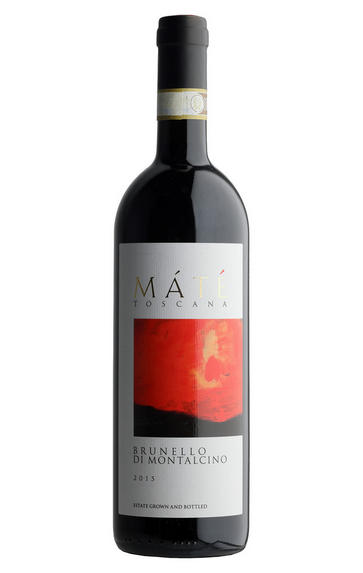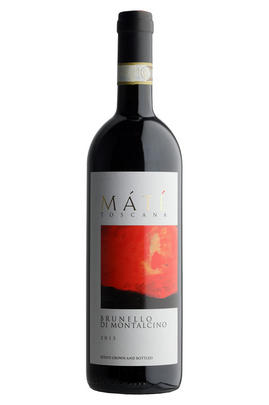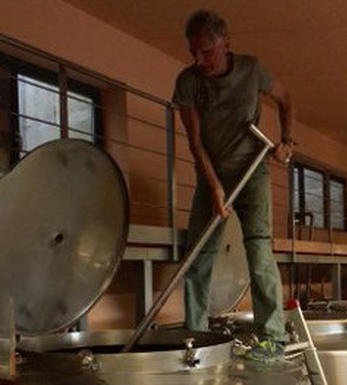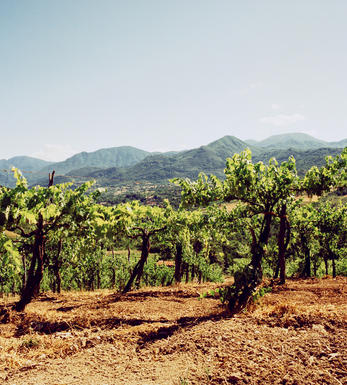
2019 Brunello di Montalcino, Máté, Tuscany, Italy

Critics reviews
The 2019 Brunello di Montalcino is extroverted in the glass. Exotic spices and cedar shavings complement medicinal cherry and sweet rose. This is soft and round on the palate, with a polished wave of ripe red and hints of blue fruit. Its tannins come forward through the finish, combined with a pleasantly bitter tinge as a tart cranberry tension lingers.
Drink 2025 - 2031
Eric Guido, Vinous (November 2023)
Certified organic by ICEA.
Just mid ruby. Minerally cherry fruit with a balsamic note of eucalyptus. Gorgeous, succulent, tangy cherry fruit mellowed by a little oak and with a layer of rich, chewy tannins. Super-seductive, with loads of character.
Drink 2024 - 2032
Walter Speller, JancisRobinson.com (October 2023)
Clear and perfumed with black-cherry and slate aromas that carry through to a medium body with fine, polished tannins and a beautiful finish. Racy and refined all around. Shows focus, finesse and structure. Same excellence as the 2015, but with more clarity. From organically grown grapes.
Best after 2026
James Suckling, JamesSuckling.com (September 2023)
Located in the area of Tavernelle, near Gaja’s Pieve Santa Restituta estate, Máté was established by husband-and-wife team author Ferenc and painter Candace in the mid-1990s. High density plantings of various clones yield a richly fruited, concentrated Brunello that absorbs its oak overcoat with ease. Coffee, vanilla and mint lend a sweet glossiness to red cherry. Racy acidity keeps it vibrant. The tannins are mature and well-formed giving frame to this stylishly rendered picture.
Drink 2024 - 2030
Michaela Morris, Decanter (November 2023)
About this WINE

Máté Winery
The family-owned and organically farmed Máté estate is in the south-west of Montalcino, in the commune of Santa Restituta. This highly desirable area is well known for producing terroir-driven wines of distinct expression. Their next-door neighbours are none other than Angelo Gaja and Gianfranco Soldera – two titans of the industry, whose wines typically command prices that soar into the hundreds of pounds per bottle.
Situated at 320-420 metres’ altitude, the 6.5 hectares of vines here are surrounded by forest, Etruscan ruins and scrubland thick with wildflowers and herbs. The soil is composed of marl, tuffo limestone and calcareous sandstone filled with marine fossils. This gives unique character and mineral poise to the wines. The calibre of the terroir is only matched by the expertise behind the wines: working with owners Candace and Ferenc Máté is chief winemaker Carlo Ferrini – a man responsible for many of Italy’s most iconic bottles, including many of Montalcino’s 100-point wines. The vineyards were planted by Gaja’s legendary agronomist Fabrizio Moltard.

Brunello di Montalcino
Along with Chianti, Brunello di Montalcino is Tuscany's most famous DOCG and the region's boldest expression of Sangiovese. Located 30 miles south of Siena with the hilltop town of Montalcino as its epicentre, its 2,000 hectares of vines are naturally delimited by the Orcia, Asso and Ombrone valleys. Brunello is the local name for the Sangiovese Grosso clone from which Brunello di Montalcino should be made in purezza (ie 100 percent).
The Brunello di Montalcino DOCG has a whale-like shape: at its head, at 661 metres above sea level on ancient, stony galestro soils facing east and southeast lies the town of Montalcino, where the DOC was founded. As you follow the spine south towards the tail, the vineyards lose altitude – those around Colle Sant'Angelo are at 250 metres – while the soils become richer with iron and clay. Further east, in the shadow of the 1,734 metre Mont'Amiata lies the village of Castelnuovo dell'Abate where the vineyards are strewn with a rich mix of galestro, granitic, volcanic, clay and schist soil types.
Historically, the zone is one of Tuscany's youngest. First praised in 1550 by Leandro Alberti for the quality of its wines, it was Tenuta Il Greppo who bottled the inaugural Brunello di Montalcino in 1888. By 1929, the region had 925 hectares of vines and 1,243 hectares of mixed crops, while in 1932 it was decreed that only those wines made and bottled within the commune could be labelled as Brunello di Montalcino. Since then, the number of producers has risen from 11 in 1960 to 230 in 2006, while over the same period the vineyards have expanded from 1,000 hectares to 12,000. The region earned its DOC in 1966, and was upgraded to DOCG in 1980.
Brunello di Montalcino cannot be released for sale until five years after the harvest, or six years in the case of Brunello di Montalcino Riserva. During this time the wines should be aged for at least two years in oak, followed by at least four months in bottle (six months for Riservas); maximum yields are 55 hl/ha.
Rosso di Montalcino is declassified Brunello di Montalcino, released for sale 18 months after the harvest.
Recommended producers: Costanti, Fuligni, Lisini, San Giuseppe, Soldera, Cerbaiona

Sangiovese
A black grape widely grown in Central Italy and the main component of Chianti and Vino Nobile di Montepulciano as well as being the sole permitted grape for the famed Brunello di Montalcino.
It is a high yielding, late ripening grape that performs best on well-drained calcareous soils on south-facing hillsides. For years it was blighted by poor clonal selection and massive overcropping - however since the 1980s the quality of Sangiovese-based wines has rocketed upwards and they are now some of the most sought after in the world.
It produces wines with pronounced tannins and acidity, though not always with great depth of colour, and its character can vary from farmyard/leather nuances through to essence of red cherries and plums. In the 1960s the advent of Super Tuscans saw bottlings of 100% Sangiovese wines, as well as the introduction of Sangiovese/Cabernet Sauvignon blends, the most famous being Tignanello.


Buying options
Add to wishlist
Description
An incredibly compelling candidate for the finest wine Candace and Ferenc Máté have produced. This matured for two years in 500l tonneaux (between a third and a quarter of which are new), followed by 12 months in larger, botti grandi. The palate is alive with bright acidity and wild black cherry, alongside clear notes of blackberry, plum and lavender. The fruit is so clearly defined and enhanced by earthiness, with a light touch of gianduja and sweet spice. This is truly invigorating, with personality and verve in abundance. The coveted, complex terroir of Santa Restituta performed exceptionally in 2019.
Drink 2026 - 2040
Berry Bros. & Rudd
wine at a glance
Delivery and quality guarantee